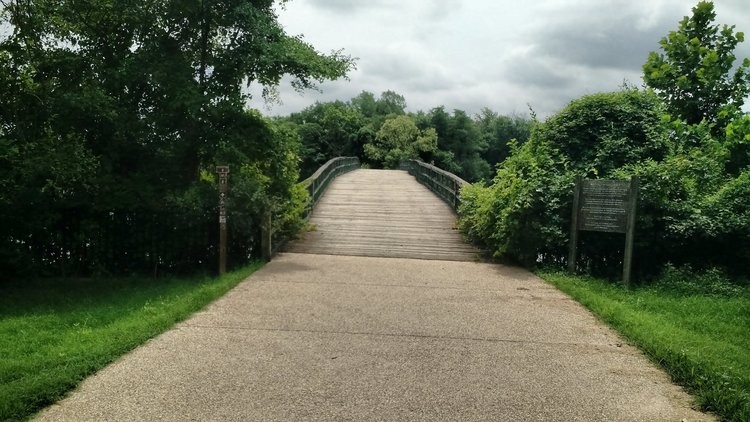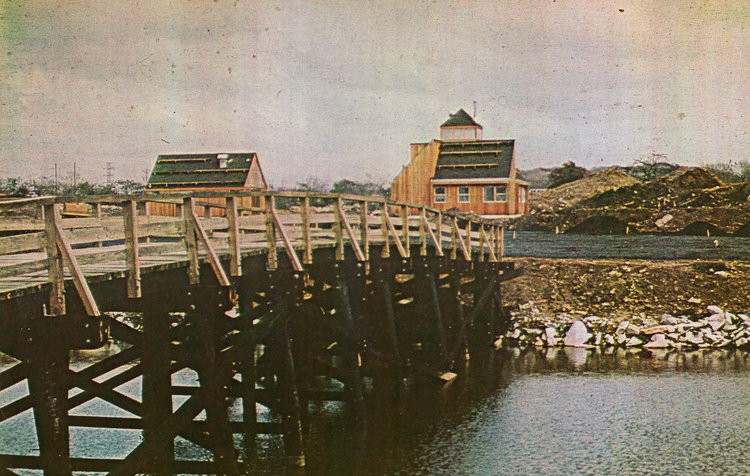A grand Bicentennial project was partly built on Kingman and Heritage Islands. Now most traces have disappeared.

Entrance to Kingman Island today.
A version of this article was first published in the Anacostia Waterfront Trust blog.
In the early 1970s, the District created a Bicentennial Commission to manage the celebration of the 200th anniversary of the American Revolution. DC Mayor Walter Washington wanted the District to have its own Bicentennial project, focused on providing new opportunities to young people by creating activity centers, and drawing new tourist dollars to city coffers.
In 1974, the head of the DC Bicentennial Commission asked Joe Henson, an assistant DC budget director, to evaluate possibilities on the southern half of Kingman Island, which was basically a dump site. Henson was a Dunbar High School graduate who had served in intelligence services in the Air Force and the State Department and worked at a high civil service level at the Department of Commerce and HUD.
Henson reported back that the Mayor’s goals could be met on Kingman Island. In January 1975, he accepted the job of transforming the island into a fun, educational park for children and families. The catch was that there was almost no budget, although Mayor Washington directed city agencies to cooperate as much as possible and promised to ask for $200,000 in the 1976 request to Congress, which directly controlled the DC budget. Opening Day was less than eighteen months away: July 4, 1976.
Henson reached out to Richard Dattner, a New York City architect who had made a national reputation by installing a popular “adventure playground” in Central Park in the late 1960s. On the promise of getting paid later, Dattner drew up ambitious plans for “National Children’s Bicentennial Island.”
According to a Washington Post article, the design included “playgrounds, a children's theater, library and museum, an international mall with rotating exhibits and demonstrations, an animal petting center, a windmill, greenhouse, nature sanctuary, ranger tower, and a carousel.”
A Native American village, an African village, a frontier village, an 18th Century schooner and paddle boats were also planned for the smaller, adjacent 1776 Island, which was renamed Heritage Island. The Commission of Fine Arts approved the designs with “enthusiastic interest.” Costs were projected at $4 million.
The master plan for National Children's Bicentennial Island 
Joe Henson and Richard Dattner had two special interests: barrier-free accessibility, and alternative energy. They wanted to make sure that all the attractions were available to kids regardless of their physical ability, and they wanted to show off solar power and other forms of earth-friendly living.
The National Park Service, which owned the two islands, gave the city a 25-year permit to proceed. Over the next several months, Henson and a handful of others threw themselves into the project. Since there was little cash available, the staff had to find project support from other local and federal government agencies.
A key issue was how visitors would come to visit the islands. Henson persuaded the Corps of Engineers to build a wooden pedestrian bridge from the RFK parking lots as a training exercise, copying the historic Old North Bridge in Concord, Massachusetts, where the first battle of the American Revolution was fought.
The pedestrian bridge to the island copying the Concord Bridge 
The Corps of Engineers also graded and buttressed the area of Kingman Island where most construction was to occur. The DC Department of Highways contributed telephone poles to use as pilings. The Department of Environmental Services donated countless dump truck loads of stone and gravel. The Department of Housing and Community Development detailed an architect.
The American Bicentennial Commission contributed funds, and Jim Patterson and Dick Hammerschlag from the National Park Service worked closely with Henson and his team to amend the poor soils of Kingman Island and choose appropriate plantings. Volunteers and workers paid by the federal Comprehensive Education and Training Act programs provided some expertise and much of the labor.
To attract private donations, a nonprofit organization called National Children’s Island, Inc. was created in early 1976. Henson, still on the DC payroll, become the nonprofit’s director, and sprinted to solicit private funding. With the help of the Washington Post’s frequent news, editorial and commentary coverage of the project, the nonprofit attracted grants and donations. The Philip L. Graham Foundation gave a generous grant for playgrounds, as did the United Planning Organization and the Henry Strong Foundation. An anonymous donor gave $13,000. CETA youth workers and the Potomac Appalachian Trail Club built and maintained 1½ miles of nature trail.
The July 4, 1976 opening deadline proved to be too ambitious, and the project wasn’t ready for the big day. But many things were progressing, and the opening was projected for 1977. Staff, contractors, and volunteers carried on. The bridge was completed, and the International Mall was blacktopped, then paved with bricks. 100 cherry trees from the Japanese government were planted around the entrance to the island.
The big break came in the form of a $900,000 grant from the federal Economic Development Administration. The grant paid for a considerable amount of underground electric and plumbing lines (including laying a sewer line to the eastern shore of the Anacostia), a solar-powered Administration Building near the brick-paved Mall, and two smaller buildings. A round structure called a yurt designed by national yurt guru Dr. William Coperthwaite was constructed on Heritage Island.
The yurt designed by Dr. Bill Coperthwaite 
The solar-power Administration Building almost finished 
When the DC Bicentennial Office closed in early 1977, oversight for the Kingman Island project passed to the DC Department of Recreation. However, Congress denied Mayor Washington’s special funding request, and with the celebration deadline passed, interest began to wane. The Department of Recreation’s funds for the project had to compete with other priorities, and, to put it mildly, the department director and the self-confident, entrepreneurial Joe Henson did not see eye-to-eye on how to keep the project moving forward.
In 1978, Marion Barry defeated Walter Washington in the Democratic primary and went on to become Mayor. The following year, his city administrator announced that District could no longer afford the project, and the buildings, at least one of which had been damaged by fire, would be immediately removed. Henson was pointedly offered an early retirement incentive to leave the government. The National Children’s Island nonprofit board redefined the project and carried on without him, looking for private investors to get things going again. In 1983, a wealthy Indian-Italian Countess, Bina Sella di Monteluce, entered the Kingman Island picture and stayed in it for the next 16 years. But that’s a tale for another day.
The most amazing thing to me about this story is that National Children’s Bicentennial Island has essentially vanished. As far as I can find, there are only three internet references to any of this. There is almost no physical evidence of what was built on the islands. There isn’t a single brick of the tens of thousands that once paved the International Mall. There is nothing left of the solar powered building, or the yurt. The foundation of the restroom building is hidden deep in the woods, charred and only recognizable by its twisted plumbing connections.
The only thing left standing is the replica of the Old North Bridge, which was rebuilt after being torched by arsonists in 1998. However, almost no one remembers why it was designed that way, or where Heritage Island got its name. It is almost as if the National Children’s Bicentennial Island project never existed.
Projects succeed or fail, and ultimately history is made, by a kaleidoscopic mix of personalities, power, politics, economics, vision, ideas, execution, salesmanship, and maybe luck. National Children’s Bicentennial Island was an ambitious vision conceived and managed by competent, energetic, well-meaning people. A lot was accomplished in a relatively brief time. But ultimately the project failed and pretty much disappeared.
Trying once again to get something good going for the District’s kids on Kingman and Heritage Islands, we need to appreciate and learn from what Henson, Harahan, and all the others tried to do 40 years ago. As the yurt guru Bill Coperthwaite once wrote, “those who guide us, who inspire us, having gone our way before, are now partners with us in building a better world.”
